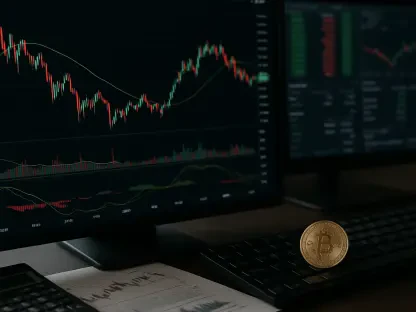The financial arena has witnessed an unprecedented level of market turbulence due to recent global events, leading investors to question the reliability of established seasonal tactics. The conventional wisdom of “sell in May and go away” and similar adages faces scrutiny as geopolitical and economic complexities present both hurdles and opportunities. This shift in dynamics beckons investors to evaluate their approach and adapt to the multifaceted realities of modern financial environments. This article delves into the intricacies of these challenges and explores emerging strategies that investors might consider adopting.
Understanding the Current Market Landscape
The stock market is currently characterized by considerable variability, predominantly influenced by unexpected geopolitical developments and shifts in economic policy. The focus is moving away from predictable seasonal patterns to factors that are more indicative of current and future market activities. The impact of international trade disputes and shifting political alliances cannot be underestimated, as they have significant ramifications on market behaviors and investor confidence.
Political events and economic conditions on a global scale hold sway over market dynamics, altering patterns that were once considered reliable. The unpredictability of such events makes it imperative for investors to remain vigilant about updates in trade agreements and international negotiations. Responding adeptly to these changes holds the key to sustaining performance in an unpredictable environment.
Unpacking Market Trends in an Unstable Environment
Key Trends and Influences on Market Behavior
Trade tensions, alterations in tax policies, and geopolitical disputes have quickly become central influences on market behavior. The traditional reliance on seasonal trends is diminishing as these more substantial elements continuously shape the financial landscape. The growing complexity of financial environments renders conventional predictors weaker, urging investors to shift focus toward macroeconomic factors and policy outcomes as critical aspects of their strategy.
Many familiar seasonal axioms have become less viable amidst the instability seen over recent years. Acknowledging the weight of political and economic factors is more crucial than relying solely on historic cycles. Investors are increasingly seeking cues from macroeconomic trends and anticipating policy shifts that could drastically alter market trajectories regardless of the time of year.
Performance Metrics and Market Projections
Recent data reveals notable deviations from former seasonal performance patterns, emphasizing a departure from predictability. Analysis of recent market performances underlines the challenges facing investors willing to rely on traditional expectations. Predictive models and forecasts highlight that future outcomes remain unforeseeable, given the current climate of uncertainty and possible volatility.
As performance varies widely from historic norms, financial strategists urge investors to consider well-rounded insights and projections that align more appropriately with the current global context. Elevated vigilance is needed to adapt successfully and capitalize on the emerging opportunities in a climate marked by rapid and unforeseeable changes.
Challenges and Complexities in Rethinking Seasonal Strategies
Reevaluating investment mandates amid chaotic market conditions involves addressing inherent complexities. The efficacy of traditional approaches is hindered by rapid policy adjustments and unforeseen political developments, both of which have recalibrated expectations to a considerable extent. Investors face the intricate task of balancing established strategies with innovations suited to current challenges.
Investors must adapt to shifting conditions, a reality made more pressing by ongoing policy revisions and global volatility. Potential strategies require reinforcing adaptability and resilience despite persistent uncertainties. By leveraging a blend of strategic foresight and operational agility, investors may discover approaches that optimize their portfolio performance in unpredictable environments.
The Role of Regulation and Policy in Market Stability
Significant regulatory changes impact investment strategies, influencing market stability and guiding adherence to compliance frameworks, emphasizing security. Policies and tariffs have far-reaching effects on the investment landscape, influencing decisions on domestic and international levels. Discussions that range from trade agreements to policy negotiations stand as pivotal elements that affect market sentiment and guide investor behavior.
Crucial evaluations of regulatory frameworks and policy adaptations are warranted to sustain stability. Timely awareness of policy negotiations and their implications across geopolitical spheres may provide competitive advantages to investment strategies. As regulations continue to evolve, attentiveness to these dimensions remains a critical part of engaging with global financial systems effectively.
Future Directions and Strategic Opportunities
Technologies poised to disrupt market behavior herald new paths for investment and innovation. Ongoing transformations in technology offer expansive opportunities as they fuel shifts in consumer preferences and economic processes. These advancements contribute to reshaping investment landscapes, suggesting fresh potential for growth in coming market cycles.
The acknowledgment of changing consumer inclinations is pivotal for anticipating economic developments and nurturing innovation. Identifying sectors for investment in an evolving terrain presents opportunities well-aligned with probable future economic transformations. Harnessing technological breakthroughs holds promise in advancing new dimensions for burgeoning industries and ventures.
Conclusion and Strategic Recommendations
In navigating through complex markets, the consideration of macroeconomic influences above seasonal indicators has so far surfaced as crucial. Embracing a comprehensive evaluation of global events and emerging strategies also represents an adequate transition for active investors. Investing efforts in understanding policy implications has become paramount to forming resilient strategies in a volatile landscape. The recognition of innovative technologies and macroeconomic shifts sustains a focus on sustainable investment strategies. As markets continue to fluctuate, investors are better positioned by focusing less on historic adages and more on evolving landscapes to achieve success.









